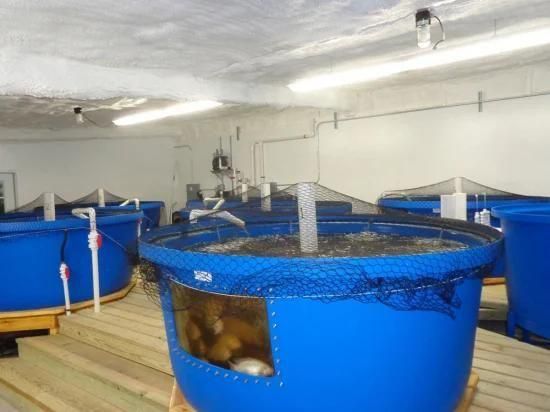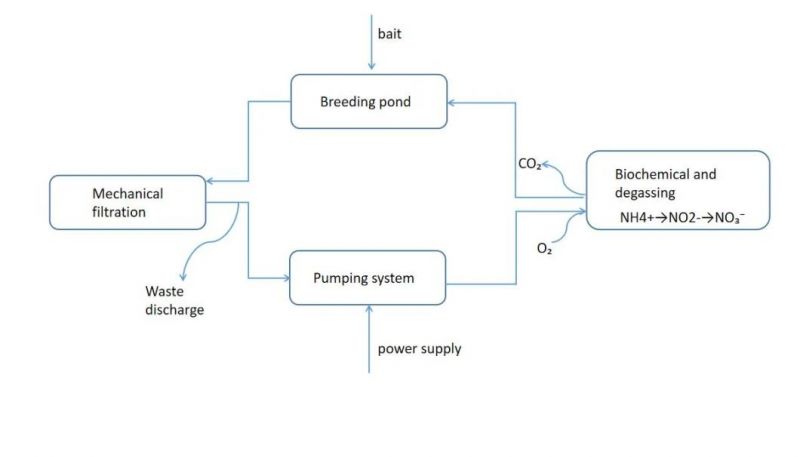
40 Cubic Ras Experimental Teaching Circulating Water Aquaculture System
HC Flourish Industry Group Co., Ltd.- Port:Guangzhou, China
- Production Capacity:50000 Pieces/Year
- Payment Terms:T/T
- After-sales Service:Installation and Maintenance Technical Guidance
- Type:Fisheries Auxiliary Machinery
- Working Method:Circulatory System
- Power Source:Electric
- Harvesting Machinery Type:Fishing Winch
- Fishing Method:Trawling Machinery
Base Info
- Model NO.:wat1
- Aquatic Products Processing Machinery:Material Handling Machinery
- Fishing Gear Winch Type:Net Hauler
- Fishing Auxiliary Machinery Type:Auxiliary Winch
- Certification:ISO9001:2008
- Condition:New
- Finished processing machinery:Fillet Machinery
- Warranty:12 Months
- Trademark:Flourish
- Transport Package:Plywood
- Specification:customized
- Origin:Make in China
- HS Code:8421299090
Description
40 cubic Ras circulating water aquaculture system
System composition Description:
1.1 sedimentation filter
Water from the fish pond is directed through the sedimentation tank. In this equipment, gravity is used to separate insoluble solid particles from system water. The sedimentation tank is equipped with specially modified polypropylene filter components. Allow solids to settle on these filters. The settled particles form a layer of sludge at the bottom of the sedimentation tank. The sludge is biologically active: up to 60% of the nitrate produced by the biofilter is denitrified into nitrogen by bacteria in the sludge. According to the feed load of the system, the sedimentation tank must be cleaned regularly. Sludge and water used for cleaning are discharged into the farm's wastewater system.
1.2 microfilter
The system water from the fish pond can also be mechanically cleaned by drum microfilter. Suspended solids are continuously and automatically removed from the system water, so the drum filter does not need daily maintenance. In the micro filter, the system water naturally flows through the filter screen. In this process, the particles in the system water are blocked by the filter screen. Due to the blockage of the filter screen, the water level in the drum will rise. When reaching a certain height, the flushing mechanism is put into operation, the drum starts to rotate, and water is sprayed from the nozzle through the filter screen from the outside of the drum under high pressure, so as to flush the waste particles from the screen. Different filter screens can be selected according to the size of fish and fish.
1.3 biofilter
During digestion of feed, fish produce NH 4 or ammonium. It is waste from protein digestion. Ammonium is toxic to fish. However, some bacteria use ammonium (NH4) to produce energy. These bacteria exist in the biodynamics of the recycling system and convert NH4 to nitrite NO2 in the atmospheric environment. Like ammonium, nitrite is highly toxic to fish, but it can cause problems at lower concentrations. Nitrite is also used as an energy source for some bacteria in biofilters. In the circulating aquaculture system, we use the mobile biological bed to complete the decomposition process. These filter fillers have high filtration capacity and low volume. Pump water from the pump tank into the moving bed filter. The moving bed filter consists of a tank with an aeration device and is filled with filter beads (available in a variety of shapes and sizes). The biofilm of nitrifying bacteria grows on the surface of beads. There are parts that can grow these bacteria under optimal conditions. These bacteria transfer nitrite in relatively harmless nitrate (NO3).
1.4 degassing tower
From the pump tank, the system water is first pumped to the biological power plant. Bioenergy is composed of polypropylene mesh filter blocks suitable for biofiltration. At the top of the biological power, water is dispersed on the filter material. The water flows through the filter assembly to the biological power receiving tank or directly back to the pump tank. A biofilm of nitrifying bacteria is formed on the surface of the filtration composition. Biodynamics can also be added to the system to remove dissolved gases (CO2) from water

System advantages:
1. Clear water fish culture can improve the quality of fish, stable water quality is more suitable for the healthy growth of fish, effectively reduce the bait coefficient, greatly shorten the breeding cycle, and improve the yield per unit area.
2. The system adopts the circulation mode of one-time water lifting, makes full use of the potential energy generated by the water level difference to complete the working cycle of the whole system, and greatly reduces the energy consumption of the system.
3. After years of continuous optimization and design, the operation of the unit is more efficient and stable. Mechanical filtration and biological filtration have good treatment effect and small floor area. The filter of the new system has the function of back cleaning without stopping operation, avoiding manual cleaning, easy to use and improving production efficiency.
System composition Description:
1.1 sedimentation filter
Water from the fish pond is directed through the sedimentation tank. In this equipment, gravity is used to separate insoluble solid particles from system water. The sedimentation tank is equipped with specially modified polypropylene filter components. Allow solids to settle on these filters. The settled particles form a layer of sludge at the bottom of the sedimentation tank. The sludge is biologically active: up to 60% of the nitrate produced by the biofilter is denitrified into nitrogen by bacteria in the sludge. According to the feed load of the system, the sedimentation tank must be cleaned regularly. Sludge and water used for cleaning are discharged into the farm's wastewater system.
1.2 microfilter
The system water from the fish pond can also be mechanically cleaned by drum microfilter. Suspended solids are continuously and automatically removed from the system water, so the drum filter does not need daily maintenance. In the micro filter, the system water naturally flows through the filter screen. In this process, the particles in the system water are blocked by the filter screen. Due to the blockage of the filter screen, the water level in the drum will rise. When reaching a certain height, the flushing mechanism is put into operation, the drum starts to rotate, and water is sprayed from the nozzle through the filter screen from the outside of the drum under high pressure, so as to flush the waste particles from the screen. Different filter screens can be selected according to the size of fish and fish.
1.3 biofilter
During digestion of feed, fish produce NH 4 or ammonium. It is waste from protein digestion. Ammonium is toxic to fish. However, some bacteria use ammonium (NH4) to produce energy. These bacteria exist in the biodynamics of the recycling system and convert NH4 to nitrite NO2 in the atmospheric environment. Like ammonium, nitrite is highly toxic to fish, but it can cause problems at lower concentrations. Nitrite is also used as an energy source for some bacteria in biofilters. In the circulating aquaculture system, we use the mobile biological bed to complete the decomposition process. These filter fillers have high filtration capacity and low volume. Pump water from the pump tank into the moving bed filter. The moving bed filter consists of a tank with an aeration device and is filled with filter beads (available in a variety of shapes and sizes). The biofilm of nitrifying bacteria grows on the surface of beads. There are parts that can grow these bacteria under optimal conditions. These bacteria transfer nitrite in relatively harmless nitrate (NO3).
1.4 degassing tower
From the pump tank, the system water is first pumped to the biological power plant. Bioenergy is composed of polypropylene mesh filter blocks suitable for biofiltration. At the top of the biological power, water is dispersed on the filter material. The water flows through the filter assembly to the biological power receiving tank or directly back to the pump tank. A biofilm of nitrifying bacteria is formed on the surface of the filtration composition. Biodynamics can also be added to the system to remove dissolved gases (CO2) from water

System advantages:
1. Clear water fish culture can improve the quality of fish, stable water quality is more suitable for the healthy growth of fish, effectively reduce the bait coefficient, greatly shorten the breeding cycle, and improve the yield per unit area.
2. The system adopts the circulation mode of one-time water lifting, makes full use of the potential energy generated by the water level difference to complete the working cycle of the whole system, and greatly reduces the energy consumption of the system.
3. After years of continuous optimization and design, the operation of the unit is more efficient and stable. Mechanical filtration and biological filtration have good treatment effect and small floor area. The filter of the new system has the function of back cleaning without stopping operation, avoiding manual cleaning, easy to use and improving production efficiency.
